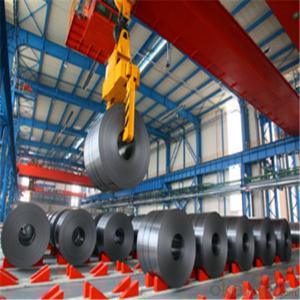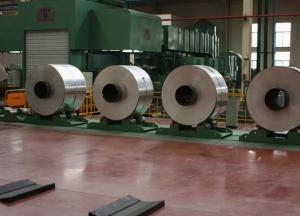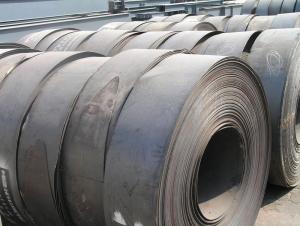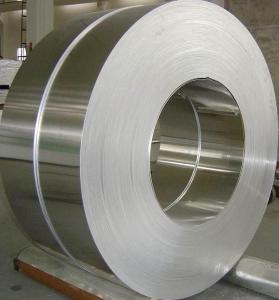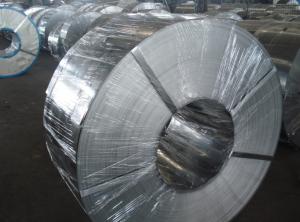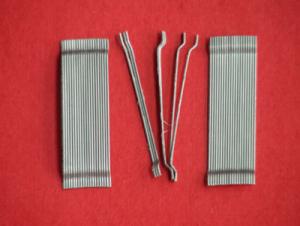Prime Quality SPCC Cold Rolled Steel Sheet/Coil in China
- Loading Port:
- China main port
- Payment Terms:
- TT OR LC
- Min Order Qty:
- 20 m.t.
- Supply Capability:
- 50000 m.t./month
OKorder Service Pledge
OKorder Financial Service
You Might Also Like
Item specifice
Prime Quality SPCC Cold Rolled Steel Sheet/coil
Widely used to appliance,automobile industry or other decoration usage.
Certificate: ISO9001
Packing Details: Wrapped by water proof paper and plastic film.Covered with iron sheet,strapped by steel strips to protect the damage under transportation.
Details please check following format
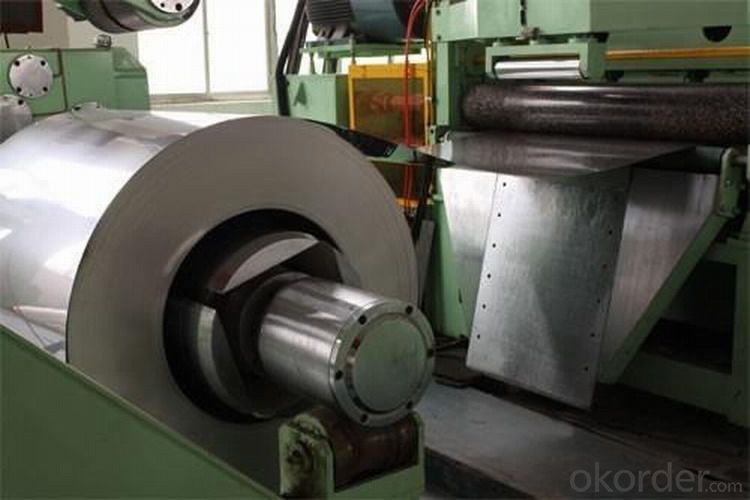
| Commodity | Stainless Steel Coil/Sheet/Strip |
| Grade NO. | 410S/430L/409 |
| Surface | 2B/BA/NO.4/Slit Edge/Mill Edge |
| Standard | JIS/GB |
| Material | Steel |
| Specification | Thickness: 0.2mm*2.0mm Width:10mm*850mm Tolerance:+/-0.02mm Coil Weight:Depond on clients |
| Technology | Cold Rolled |
| Certification | SGS |
| Application | Dinner set Kitchen ware Owner frame of security door Auto vent-pipe Vacuum cup Clean bucket water sink and so on. |
| Advantage | Attracting Price; High suface quality,clean; Good appearance of whole coil; First-rate service. |
| Package | Good Export packing/Package |
| Delivery | Within 15-20 days |
| Payment | T/T, L/C |
| Shipment | FOB/CFR/CIF/EXW |
| Productivity | 4000MT/month |
| Note | We can accept clients' any requirements as much as possible. |
1. Q: Where is your company located? How can I visit there?
A: Our company is located in Beijing, China. Welcome to visit us.
2. Q: Can I get sample and how long will it take?
A:Yes. We can supply sample. And you need to pay for courier.
3. Q: What's the MOQ?
A: Our MOQ is 25mt.
4. Q: What's the delivery time?
A: It will take about 30 days after TT or L/C.
5. Q: What is the payment terms?
A: T/T, L/C at sight
6. Q: How does your factory carry out quality control?
A: We attach great importance to quality control.Every part of our products has its own QC.
7. Q: What certificate do you have?
A: We have SGS, ISO9001 etc.
- Q:How is steel profiled and cut?
- Steel can be profiled and cut using various methods such as plasma cutting, laser cutting, waterjet cutting, and shearing. These methods involve the use of specialized machinery and tools to accurately shape and trim steel profiles according to specific dimensions and designs.
- Q:What are the different types of steel beams and their applications?
- There are several different types of steel beams commonly used in construction and structural engineering. Some of the most common types include I-beams, H-beams, and S-beams. I-beams, also known as universal beams, have an "I" shape and are widely used for structural support in buildings, bridges, and other heavy construction projects. They are known for their high strength-to-weight ratio, making them ideal for carrying heavy loads over long spans. H-beams, or wide flange beams, have a wider flange and narrower web compared to I-beams. They are commonly used in residential and commercial construction, as well as in the manufacturing and automotive industries. H-beams are versatile and can withstand heavy loads and resist bending, making them suitable for applications that require extra strength. S-beams, also known as American Standard beams or S shapes, have a tapered flange and are commonly used in industrial and commercial construction projects. They are primarily used for support structures, such as columns and beams, and are known for their stability and durability. The choice of steel beam type depends on the specific requirements of the project, including load-bearing capacity, span length, and overall structural design. Consulting with a structural engineer is crucial to determine the appropriate type of steel beam for each application.
- Q:What are the different types of steel forgings and their applications in the oil and gas industry?
- There are several types of steel forgings commonly used in the oil and gas industry. These include open die forgings, closed die forgings, and rolled ring forgings. Open die forgings are typically used for large and complex shapes, such as pressure vessels and wellhead components. They offer excellent strength and durability, making them suitable for various applications in the oil and gas industry. Closed die forgings, also known as impression die forgings, are used for smaller, intricate components like valves, fittings, and flanges. They provide superior dimensional accuracy and precise control over the final shape, making them ideal for critical parts in the oil and gas sector. Rolled ring forgings are commonly used for seamless rings, such as bearing races, gears, and flanges. They offer exceptional strength and fatigue resistance, making them suitable for high-pressure applications in the oil and gas industry. Overall, steel forgings play a crucial role in the oil and gas industry, providing robust and reliable components that can withstand harsh operating conditions, high pressures, and extreme temperatures.
- Q:What are the different types of steel products used in the manufacturing of musical instruments?
- There are several types of steel products used in the manufacturing of musical instruments, including stainless steel, carbon steel, and nickel-plated steel. Stainless steel is commonly used for instrument bodies and parts due to its corrosion resistance and durability. Carbon steel is often used for instrument springs, as it provides strength and flexibility. Nickel-plated steel is commonly used for guitar strings, as it enhances tone and increases longevity.
- Q:How is steel tubing used in manufacturing?
- Steel tubing is commonly used in manufacturing for various applications such as structural support, fluid transportation, and conveying materials. It is often used in the construction of buildings, bridges, and machinery due to its strength, durability, and resistance to corrosion. Additionally, steel tubing is used in the production of automobiles, appliances, and various industrial equipment, where it provides a reliable and efficient means of conveying fluids, gases, and materials. Overall, steel tubing plays a crucial role in the manufacturing industry by providing a versatile and cost-effective solution for numerous applications.
- Q:What are the advantages of using steel bars in construction?
- There are several advantages of using steel bars in construction. Firstly, steel bars provide excellent tensile strength, making them ideal for reinforcing concrete structures and enhancing their load-bearing capacity. Additionally, steel bars are highly durable and resistant to corrosion, ensuring the longevity and structural integrity of the construction. Moreover, steel bars are versatile and can be easily molded and shaped to fit various construction needs, making them suitable for a wide range of applications. Lastly, using steel bars in construction allows for efficient and cost-effective building processes, as they can be prefabricated off-site and easily transported to the construction site.
- Q:What are the different types of steel stair treads and nosings?
- There are various types of steel stair treads and nosings available, including diamond plate treads, perforated treads, bar grating treads, and non-slip nosings. These options offer different levels of slip resistance, durability, and aesthetic appeal, catering to various safety and design requirements.
- Q:What are the applications of steel forgings in the automotive industry?
- Steel forgings have a wide range of applications in the automotive industry. They are commonly used in critical components such as engine parts, transmission gears, steering systems, suspension components, and axles. Steel forgings offer exceptional strength, durability, and resistance to wear and tear, making them ideal for withstanding the demanding conditions of automotive operations. Additionally, their precise shaping and dimensional accuracy contribute to improved performance, safety, and fuel efficiency in vehicles.
- Q:What are the challenges faced in the welding of steel products?
- Some of the challenges faced in the welding of steel products include achieving proper weld penetration, ensuring proper heat distribution, managing distortion and warping, dealing with welding fumes and safety hazards, and maintaining weld quality and integrity.
- Q:How does steel plate rolling work?
- Steel plate rolling is a metalworking process that involves passing a heated metal plate through a set of rollers to shape it into a desired form. The rollers apply pressure to the plate, gradually bending it until the desired curvature is achieved. This process allows for the production of various steel plate products used in construction, manufacturing, and other industries.
1. Manufacturer Overview |
|
|---|---|
| Location | |
| Year Established | |
| Annual Output Value | |
| Main Markets | |
| Company Certifications | |
2. Manufacturer Certificates |
|
|---|---|
| a) Certification Name | |
| Range | |
| Reference | |
| Validity Period | |
3. Manufacturer Capability |
|
|---|---|
| a)Trade Capacity | |
| Nearest Port | |
| Export Percentage | |
| No.of Employees in Trade Department | |
| Language Spoken: | |
| b)Factory Information | |
| Factory Size: | |
| No. of Production Lines | |
| Contract Manufacturing | |
| Product Price Range | |
Send your message to us
Prime Quality SPCC Cold Rolled Steel Sheet/Coil in China
- Loading Port:
- China main port
- Payment Terms:
- TT OR LC
- Min Order Qty:
- 20 m.t.
- Supply Capability:
- 50000 m.t./month
OKorder Service Pledge
OKorder Financial Service
Similar products
New products
Hot products
Hot Searches
Related keywords
